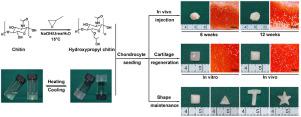当前位置:
X-MOL 学术
›
Acta Biomater.
›
论文详情
Our official English website, www.x-mol.net, welcomes your
feedback! (Note: you will need to create a separate account there.)
A moldable thermosensitive hydroxypropyl chitin hydrogel for 3D cartilage regeneration in vitro and in vivo.
Acta Biomaterialia ( IF 9.4 ) Pub Date : 2020-04-05 , DOI: 10.1016/j.actbio.2020.03.039 Yawen Xu 1 , Yong Xu 2 , Bo Bi 3 , Mengjie Hou 1 , Lin Yao 4 , Qiran Du 5 , Aijuan He 6 , Yu Liu 4 , Chunlei Miao 4 , Xiaoqin Liang 4 , Xulin Jiang 3 , Guangdong Zhou 7 , Yilin Cao 1
Acta Biomaterialia ( IF 9.4 ) Pub Date : 2020-04-05 , DOI: 10.1016/j.actbio.2020.03.039 Yawen Xu 1 , Yong Xu 2 , Bo Bi 3 , Mengjie Hou 1 , Lin Yao 4 , Qiran Du 5 , Aijuan He 6 , Yu Liu 4 , Chunlei Miao 4 , Xiaoqin Liang 4 , Xulin Jiang 3 , Guangdong Zhou 7 , Yilin Cao 1
Affiliation

|
Because of poor self-repair capacity, the repair of cartilage defect is always a great challenge in clinical treatment. In vitro cartilage regeneration provides a potential strategy for functional reconstruction of cartilage defect. Hydrogel has been known as an ideal cartilage regeneration scaffold. However, to date, in vitro cartilage regeneration based on hydrogel has not achieved satisfactory results. The current study explored the feasibility of in vitro 3D cartilage regeneration based on a moldable thermosensitive hydroxypropyl chitin (HPCH) hydrogel and its in vivo fate. The thermosensitive HPCH hydrogel was prepared and characterized. Goat auricular chondrocytes were encapsulated into the HPCH hydrogel to form a chondrocyte-hydrogel construct. The constructs were injected subcutaneously into nude mice or molded into different shapes for in vitro chondrogenic culture followed by in vivo implantation. The results demonstrated that the HPCH hydrogel possessed satisfactory gelation properties (gelation time < 18 s at 37 °C), biocompatibility (cell amount almost doubled within one week), and the ability to be applied as an injectable hydrogel for cartilage regeneration. All the constructs of in vitro culture basically maintained their original shapes (in vitro to initial: 110.8%) and displayed typical cartilaginous features with abundant lacunae and cartilage specific matrix deposition. These in vitro samples became more mature with prolonged in vivo implantation and largely maintained the original shape (in vivo to in vitro: 103.5%). These results suggested that the moldable thermosensitive HPCH hydrogel can serve as a promising scaffold for cartilage regeneration with defined shapes in vitro and in vivo. STATEMENT OF SIGNIFICANCE: Because of avascular and non-nervous characteristic of cartilage, in vitro regeneration plays an important role in reconstructing cartilage function. Hydrogel has been known as an ideal cartilage regeneration scaffold. However, to date, in vitro cartilage regeneration based on hydrogel has not achieved satisfactory results. The current study demonstrated that the chondrocyte-hydrogel construct generated by high density of chondrocytes encapsulated into a thermosensitive HPCH hydrogel could successfully regenerate in vitro typical cartilage-like tissue with defined shapes and further mature to form homogeneous cartilage with their original shapes after in vivo implantation. The current study indicated that the moldable thermosensitive HPCH hydrogel could serve as a promising scaffold for in vitro and in vivo cartilage regeneration with different shapes.
中文翻译:

用于体外和体内3D软骨再生的可模塑热敏羟丙基甲壳质水凝胶。
由于自我修复能力差,软骨缺损的修复一直是临床治疗中的巨大挑战。体外软骨再生为软骨缺损的功能重建提供了潜在的策略。水凝胶已被称为理想的软骨再生支架。然而,迄今为止,基于水凝胶的体外软骨再生尚未取得令人满意的结果。当前的研究探索了基于可模塑热敏羟丙基几丁质(HPCH)水凝胶及其体内命运的体外3D软骨再生的可行性。制备并表征了热敏HPCH水凝胶。将山羊耳软骨细胞封装到HPCH水凝胶中以形成软骨细胞-水凝胶构建体。将构建体皮下注射到裸鼠中或模制成不同的形状,用于体外软骨培养,然后体内植入。结果表明,HPCH水凝胶具有令人满意的凝胶特性(在37°C下凝胶时间<18 s),生物相容性(一周内细胞数量几乎翻倍),并具有用作软骨再生的可注射水凝胶的能力。体外培养的所有构建体基本保持其原始形状(体外至初始:110.8%),并显示出典型的软骨特征,具有丰富的腔隙和特定于软骨的基质沉积。随着体外植入时间的延长,这些体外样品变得更加成熟,并在很大程度上保持了原始形状(体内到体外:103.5%)。这些结果表明,可模压的热敏HPCH水凝胶可以作为有希望的体外和体内软骨再生支架,具有确定的形状。意义声明:由于软骨的无血管和非神经特性,体外再生在重建软骨功能中起着重要作用。水凝胶已被称为理想的软骨再生支架。然而,迄今为止,基于水凝胶的体外软骨再生尚未取得令人满意的结果。目前的研究表明,由高密度软骨细胞封装到热敏HPCH水凝胶中生成的软骨细胞-水凝胶结构可以成功地再生具有定义形状的体外典型软骨样组织,并在体内植入后进一步成熟以形成具有其原始形状的均质软骨。当前的研究表明,可模压的热敏HPCH水凝胶可以作为有前途的体外和体内不同形状软骨再生的支架。
更新日期:2020-04-05
中文翻译:

用于体外和体内3D软骨再生的可模塑热敏羟丙基甲壳质水凝胶。
由于自我修复能力差,软骨缺损的修复一直是临床治疗中的巨大挑战。体外软骨再生为软骨缺损的功能重建提供了潜在的策略。水凝胶已被称为理想的软骨再生支架。然而,迄今为止,基于水凝胶的体外软骨再生尚未取得令人满意的结果。当前的研究探索了基于可模塑热敏羟丙基几丁质(HPCH)水凝胶及其体内命运的体外3D软骨再生的可行性。制备并表征了热敏HPCH水凝胶。将山羊耳软骨细胞封装到HPCH水凝胶中以形成软骨细胞-水凝胶构建体。将构建体皮下注射到裸鼠中或模制成不同的形状,用于体外软骨培养,然后体内植入。结果表明,HPCH水凝胶具有令人满意的凝胶特性(在37°C下凝胶时间<18 s),生物相容性(一周内细胞数量几乎翻倍),并具有用作软骨再生的可注射水凝胶的能力。体外培养的所有构建体基本保持其原始形状(体外至初始:110.8%),并显示出典型的软骨特征,具有丰富的腔隙和特定于软骨的基质沉积。随着体外植入时间的延长,这些体外样品变得更加成熟,并在很大程度上保持了原始形状(体内到体外:103.5%)。这些结果表明,可模压的热敏HPCH水凝胶可以作为有希望的体外和体内软骨再生支架,具有确定的形状。意义声明:由于软骨的无血管和非神经特性,体外再生在重建软骨功能中起着重要作用。水凝胶已被称为理想的软骨再生支架。然而,迄今为止,基于水凝胶的体外软骨再生尚未取得令人满意的结果。目前的研究表明,由高密度软骨细胞封装到热敏HPCH水凝胶中生成的软骨细胞-水凝胶结构可以成功地再生具有定义形状的体外典型软骨样组织,并在体内植入后进一步成熟以形成具有其原始形状的均质软骨。当前的研究表明,可模压的热敏HPCH水凝胶可以作为有前途的体外和体内不同形状软骨再生的支架。











































 京公网安备 11010802027423号
京公网安备 11010802027423号